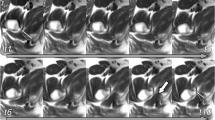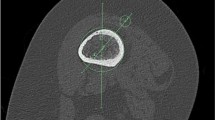Abstract
Background
Injuries to the quadratus femoris (QF) muscle have only recently appeared in the medical literature with the increasing use of advanced imaging in assessing musculoskeletal complaints in the gluteal region. Both strains of the QF muscle and impingement of the QF muscle within the ischiofemoral (IF) space can appear similar on imaging, and normative data of the IF space is important in establishing guidelines for defining these conditions.
Purpose
One purpose of this study was to quantitatively describe the IF and QF spaces. The second goal of this paper was to describe gross abnormalities seen in the QF muscle, and determine if the appearance of the muscle is associated with pelvimetric measurements.
Methods
Quantitative measurements were taken of the IF and QF spaces on 16 cadavers (29 hips). The QF muscle was then examined and assigned a quantitative grade.
Results
The mean IF space was 23.5 ± 4.7 mm and QF space was 20.4 ± 5.6 mm. Abnormalities of the QF muscle were observed in 51.7 % of the hips, and were associated with a greater approximation when moving the hip from neutral to maximally extended–adducted.
Conclusion
While degenerative changes were present in the majority of QF muscles, these changes were not associated with the size of the IF or QF space. However, there was a significant association between the degree of degenerative change observed and (1) an increased approximation of the QF attachments sites; and (2) a narrower intertuberous diameter.




Similar content being viewed by others
References
Ali AM, Whitwell D, Ostlere SJ (2011) Case report: imaging and surgical treatment of a snapping hip due to ischiofemoral impingement. Skeletal Radiol 40:653–656
Bano A, Karantanas A, Pasku D, Datseris G, Tzanakakis G, Katonis P (2010) Persistent sciatica induced by quadratus femoris muscle tear and treated by surgical decompression: a case report. J Med Case Rep 4:236
Blankenbaker DG, Tuite MJ (2006) The painful hip: new concepts. Skeletal Radiol 35:352–370
Bui-Mansfield LT, O’Brien SD (2008) Reply (letter). Am J Roentgenol 190:W380–W381
Deutsch A, Altchek DW, Schwartz E, Otis JC, Warren RF (1996) Radiologic measurement of superior displacement of the humeral head in the impingement syndrome. J Shoulder Elbow Surg 5:186–193
Goutallier D, Postel JM, Bernageau J, Lavau L, Voisin MC (1994) Fatty muscle degeneration in cuff ruptures: pre- and postoperative evaluation by CT scan. Clin Orthop Relat Res 304:78–83
Gray H (2000) Anatomy of the human body, 20th edn. http://www.bartleby.com/107/58.html. Accessed 10 June 2011
Greene WB, Heckman JD (1994) The clinical measurement of joint motion. American Academy of Orthopaedic Surgeons. Rosemont, Illinois, p 105
Irlenbusch U, Gansen HK (2003) Muscle biopsy investigations on neuromuscular insufficiency of the rotator cuff: a contribution to the functional impingement of the shoulder joint. J Shoulder Elbow Surg 12:422–426
Johnson KA (1977) Impingement of the lesser trochanter on the ischial ramus after total hip arthroplasty: report of three cases. J Bone Joint Surg Am 59:268–269
Kassarjian A (2008) Signal abnormalities in the quadratus femoris muscle: tear or impingement? (letter). Am J Roentgenol 190:W379
Klinkert P Jr, Porte RJ, de Rooij TP, de Vries AC (1997) Quadratus femoris tendinitis as a cause of groin pain. Br J Sports Med 31:3348–3349
Lenhard M, Johnson T, Weckbach S, Nikolaou K, Friese K, Hasbargen U (2009) Three-dimensional pelvimetry by computed tomography. Radiol Med 114(5):827–834
Morelli V, Smith V (2001) Groin injuries in athletes. Am Fam Physician 64:1405–1414
Murrell GA, Walton JR (2001) Diagnosis of rotator cuff tears (letter). Lancet 357:769–770 (Published correction appears in Lancet 2001;357:1452)
O’Brien SD, Bui-Mansfield LT (2007) MRI of quadratus femoris muscle tear: another cause of hip pain. Am J Roentgenol 189:1185–1189
Patti JW, Ouellette H, Bredella MA, Torriani M (2008) Impingement of lesser trochanter on ischium as a potential cause for hip pain. Skeletal Radiol 37:939–941
Peltola K, Heinonen OJ, Orava S, Mattila K (1999) Quadratus femoris muscle tear: an uncommon cause for radiating gluteal pain. Clin J Sport Med 9:228–230
Pfirrmann CWA, Zanetti M, Weishaupt D, Gerber C, Hodler J (1999) Subscapularis tendon tears: detection and grading at MR arthrography. Radiology 213:709–714
Salerno G, Daniels IR, Brown G, Heald RJ, Moran BJ (2006) Magnetic resonance imaging pelvimetry in 186 patients with rectal cancer confirms an overlap in pelvic size between males and females. Colorectal Dis 8(9):772–776
Schroeder CF, Schmidtke SZ, Bidez MW (1997) Measuring the human pelvis: a comparison of direct and radiographic techniques using a modern United States-based sample. Am J Phys Anthropol 103(4):471–479
Tempelhof S, Rupp S, Seil R (1999) Age-related prevalence of rotator cuff tears in asymptomatic shoulders. J Shoulder Elbow Surg 8:296–299
Torriani M, Souto SCL, Thomas BJ, Ouellette H, Bredella MA (2009) Ischiofemoral impingement syndrome: an entity with hip pain and abnormalities of the quadratus femoris muscle. Am J Roentgenol 193:186–190
Willick SE, Lazarus M, Pres JM (2002) Quadratus femoris muscle strain. Clin J Sports Med 12:130–131
Worland RL, Lee D, Orozco CG, Soza Rex F, Keenan J (2003) Correlation of age, acromial morphology, and rotator cuff tear pathology diagnosed by ultrasound in asymptomatic patients. J South Orthop Assoc 12:23–26
Conflict of interest
The authors declare that they have no conflict of interest.
Author information
Authors and Affiliations
Corresponding author
Rights and permissions
About this article
Cite this article
Sussman, W.I., Han, E. & Schuenke, M.D. Quantitative assessment of the ischiofemoral space and evidence of degenerative changes in the quadratus femoris muscle. Surg Radiol Anat 35, 273–281 (2013). https://doi.org/10.1007/s00276-012-1029-5
Received:
Accepted:
Published:
Issue Date:
DOI: https://doi.org/10.1007/s00276-012-1029-5




